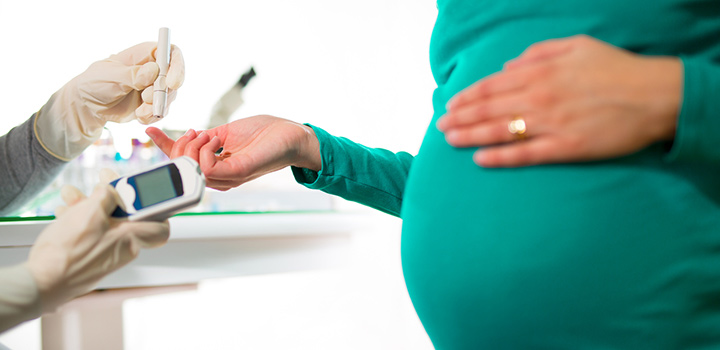Gestational Diabetes: A Complete Guide For Expectant Mothers

Gestational Diabetes: A Complete Guide For Expecting Mothers
Gestational Diabetes is a form of diabetes that develops during pregnancy. It occurs when the body cannot produce enough insulin to regulate blood sugar levels during pregnancy. It is important to note that gestational diabetes is different from pre-existing diabetes, and while it may resolve after birth, it still requires management to prevent complications for both mother and baby.
This comprehensive guide will cover gestational diabetes in detail, including what it is, how it affects the body, and most importantly, how to manage it. By following the right plan, most women can successfully manage gestational diabetes, and in many cases, avoid the need for medication.
What is Gestational Diabetes?
Gestational Diabetes (GDM) is a type of diabetes that occurs during pregnancy. It develops when the body is unable to produce enough insulin to handle the extra blood sugar produced during pregnancy. This condition usually develops during the second or third trimester and affects up to 10% of pregnancies globally.
During pregnancy, the placenta produces hormones that can interfere with the body’s ability to use insulin efficiently. This is known as insulin resistance, and it can cause high blood sugar levels (hyperglycemia). Gestational diabetes increases the risk of both maternal and fetal complications, but with proper care, these risks can be minimized.
How is Gestational Diabetes Diagnosed?
Gestational diabetes is typically diagnosed through a blood glucose test that is performed between the 24th and 28th week of pregnancy. The test measures the body’s ability to process sugar. If the blood sugar levels are too high, gestational diabetes is diagnosed.
- Glucose Challenge Test (GCT): This is usually the first test, where you drink a sugary solution, and then your blood sugar is tested after one hour.
- Oral Glucose Tolerance Test (OGTT): If your GCT results are high, you may be asked to undergo an OGTT, which measures blood sugar levels over a period of time after consuming a sugary drink.
If diagnosed, gestational diabetes is managed with diet, exercise, and sometimes medications like insulin.
What Causes Gestational Diabetes?
The exact cause of gestational diabetes is not fully understood. However, it is believed to be related to the hormonal changes that occur during pregnancy. The placenta produces hormones to support the pregnancy, but these hormones can also block the action of insulin, a phenomenon known as insulin resistance.
In gestational diabetes, the pancreas cannot keep up with the increased insulin demand, causing blood sugar levels to rise. Though gestational diabetes is not caused by a poor diet, women who are overweight or have family histories of diabetes are at a higher risk.
What Are the Risks of Gestational Diabetes?
If gestational diabetes is not managed properly, it can lead to a variety of complications for both mother and baby. These include:
For the Baby:
- Macrosomia (Excessive Birth Weight): High blood sugar levels can lead to the baby growing larger than usual, making delivery more difficult.
- Preterm Birth: Babies born prematurely may face respiratory issues and other complications.
- Low Blood Sugar (Hypoglycemia) at Birth: Babies of mothers with gestational diabetes may experience low blood sugar levels after birth, which can lead to complications.
- Respiratory Distress Syndrome: High blood sugar can affect lung development, leading to breathing difficulties at birth.
- Increased Risk of Developing Type 2 Diabetes Later in Life: Babies born to mothers with gestational diabetes are more likely to develop Type 2 diabetes as they grow older.
For the Mother:
- Increased Risk of Type 2 Diabetes Later: Women who have had gestational diabetes are at a higher risk of developing Type 2 diabetes later in life.
- High Blood Pressure or Preeclampsia: Gestational diabetes increases the risk of high blood pressure, which can lead to complications such as preeclampsia.
- Cesarean Section (C-Section): The risk of needing a C-section increases if the baby is too large or if there are other complications during delivery.
- Future Gestational Diabetes: Women who have gestational diabetes are more likely to develop it again in future pregnancies.
How to Manage Gestational Diabetes:
Managing gestational diabetes involves keeping blood sugar levels under control, which can often be achieved with lifestyle changes such as diet, exercise, and blood sugar monitoring. In some cases, medication or insulin may be needed.
1. Follow a Blood Sugar-Friendly Meal Plan
A well-balanced, blood sugar-friendly diet is essential for managing gestational diabetes. This involves eating foods that stabilize blood sugar levels and provide the necessary nutrients for both mother and baby.
- What to Eat:
- Non-starchy vegetables (e.g., spinach, broccoli, cucumbers)
- Whole grains in small portions (e.g., quinoa, brown rice, oats)
- Lean proteins (e.g., eggs, chicken, tofu, Greek yogurt)
- Healthy fats (e.g., avocados, olive oil, nuts)
- What to Avoid:
- Sugary foods (e.g., sweets, juices, sodas)
- White carbs (e.g., white bread, pasta, rice)
- Ultra-processed snacks
Eating smaller meals throughout the day, with 3 main meals and 2–3 snacks, can also help maintain stable blood sugar levels.
2. Stay Active Every Day
Regular physical activity helps improve insulin sensitivity and lowers blood sugar levels. However, exercise should be gentle and safe for both mother and baby.
- Exercise Options:
- Brisk walking (15–30 minutes after meals)
- Prenatal yoga
- Swimming or light stationary biking
Exercise is key to blood sugar control and improving overall pregnancy health.
3. Drink Plenty of Water
Hydration is important for managing gestational diabetes. Drinking enough water helps the kidneys flush excess glucose out of the bloodstream.
- Goal: Aim for at least 8–10 glasses of water per day.
Proper hydration prevents dehydration and supports healthy kidney function during pregnancy.

4. Monitor Your Blood Sugar Regularly
Blood sugar monitoring is a crucial part of managing gestational diabetes. Checking your blood sugar levels helps you understand how different foods, activities, and medications affect your glucose levels.
- How to Monitor:
- Check blood sugar levels 4 times a day:
- Fasting (before breakfast)
- 1-hour after meals
- 2-hours after meals
- Check blood sugar levels 4 times a day:
- Target Blood Sugar Levels:
- Fasting: ≤ 95 mg/dL
- 1-hour after meals: ≤ 140 mg/dL
- 2-hours after meals: ≤ 120 mg/dL
5. Manage Stress and Sleep
Chronic stress and poor sleep can increase blood sugar levels. Managing stress and getting enough sleep are vital for maintaining blood sugar balance.
- Stress Management: Practice deep breathing, meditation, or gentle stretching to lower cortisol levels, which can negatively impact blood sugar.
- Sleep: Aim for 7–9 hours of restful sleep each night.
6. Medication or Insulin if Needed
If lifestyle changes like diet and exercise are not enough to control your blood sugar, your healthcare provider may recommend:
- Insulin injections (considered the safest during pregnancy)
- Occasionally, oral medications (if insulin is not sufficient)
Does Gestational Diabetes Go Away After Delivery?
Yes, gestational diabetes usually goes away after childbirth. Most women see their blood sugar levels return to normal within a few days to weeks after delivery, as the hormones produced by the placenta are no longer present.
However, gestational diabetes is a warning sign that the mother is at a higher risk of developing Type 2 diabetes later in life. It’s important for mothers to continue monitoring their blood sugar levels postpartum and maintain a healthy lifestyle to reduce long-term risks.
- Postpartum Monitoring: After delivery, your doctor will typically recheck your blood sugar 6–12 weeks after birth with an oral glucose tolerance test (OGTT).

How to Prevent Type 2 Diabetes After Gestational Diabetes
Though gestational diabetes often resolves after pregnancy, it leaves women with a much higher risk of developing Type 2 diabetes later in life. To reduce the risk, it’s essential to:
- Eat a balanced, low-sugar, high-fiber diet
- Exercise regularly (walking, strength training, yoga)
- Maintain a healthy weight
- Breastfeeding, if possible, helps regulate metabolism and improve insulin sensitivity
- Get annual checkups to monitor blood sugar levels
Conclusion
Gestational diabetes is a serious condition, but it can be managed effectively with lifestyle changes, proper care, and regular monitoring. By following a healthy diet, staying active, and managing stress and sleep, most women can avoid complications during pregnancy. Although gestational diabetes typically resolves after birth, it significantly increases the risk of Type 2 diabetes later in life, so it is important to maintain healthy habits after delivery to reduce long-term risks.
Regular monitoring and healthcare follow-ups are crucial to ensuring a healthy pregnancy and a healthy future for both mother and baby.
Written by:
Dr. Laura Chen, MD, Endocrinologist
Dr. Laura Chen is a board-certified endocrinologist with over 15 years of experience specializing in diabetes management, particularly during pregnancy. Her helps expecting mothers manage their diabetes safely through lifestyle changes, medications, and continuous support.
Reviewed by:
Michael Tan, RD, Registered Dietitian
Michael Tan is a registered dietitian with over 10 years of experience helping women manage gestational diabetes through diet, exercise, and healthy lifestyle changes.
References:
- Calvo, M. J. The placental role in gestational diabetes mellitus. Frontiers in Cardiovascular Medicine https://pmc.ncbi.nlm.nih.gov/articles/PMC11132656/
- Yang, Y., & Wu, N. (2022). Gestational diabetes mellitus and preeclampsia: Correlation and influencing factors. Frontiers in Cardiovascular Medicine, https://pmc.ncbi.nlm.nih.gov/articles/PMC8889031/
- American Diabetes Association. (n.d.). Diabetes diagnosis & tests. https://diabetes.org/about-diabetes/diagnosis








4 thoughts on “Gestational Diabetes: A Complete Guide For Expectant Mothers”